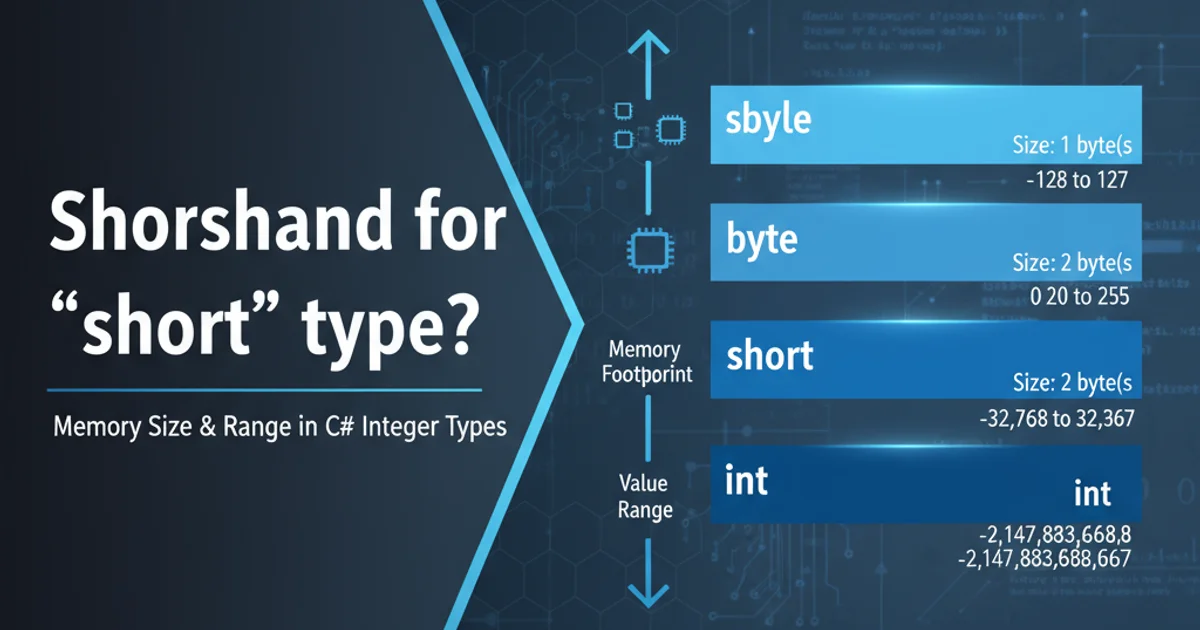Shorthand for `short` type?
short type? with practical examples, diagrams, and best practices. Covers c#, short development techniques with visual explanations.Categories:
Understanding the 'short' Type and its Shorthand in C#

Explore the short data type in C#, its range, usage, and the common shorthand alias provided by the .NET framework.
In C#, data types are fundamental for defining the kind of values a variable can hold. Among the various integer types, short is a specific type designed to store relatively small whole numbers. This article delves into the short type, its characteristics, and the convenient shorthand provided by the C# language, which is crucial for writing concise and readable code.
What is the short Data Type?
The short data type in C# is a 16-bit signed integer. This means it can store whole numbers, both positive and negative, within a specific range. It's part of the value types in C# and is typically used when memory efficiency is a concern or when dealing with values that are known to fit within its limited range. Understanding its boundaries is key to preventing overflow errors.
using System;
public class ShortTypeInfo
{
public static void Main(string[] args)
{
short minShort = short.MinValue;
short maxShort = short.MaxValue;
Console.WriteLine($"Minimum value of short: {minShort}");
Console.WriteLine($"Maximum value of short: {maxShort}");
short myShort = 12345;
Console.WriteLine($"My short value: {myShort}");
// Example of potential overflow (will cause compile-time error if literal is too large)
// short tooBig = 33000; // Error: Constant value '33000' cannot be converted to a 'short'
}
}
Demonstrating the range and basic usage of the short data type.
The Shorthand for short: System.Int16
While short is the keyword you'll commonly use in C# code, it's actually an alias for a type defined in the .NET Framework's System namespace. The fully qualified name for the short type is System.Int16. This means that whenever you declare a variable as short, the compiler internally treats it as System.Int16. This shorthand simplifies code and makes it more readable, aligning with C#'s design philosophy of providing convenient aliases for common .NET types.
flowchart TD
A[C# Keyword 'short'] --> B["Compiler Interpretation"]
B --> C["CLR Type 'System.Int16'"]
C --> D["Memory Allocation (16-bit signed integer)"]
D --> E["Value Range (-32,768 to 32,767)"]Relationship between the short keyword and its underlying System.Int16 type.
using System;
public class ShortShorthand
{
public static void Main(string[] args)
{
// Using the C# keyword shorthand
short a = 100;
Console.WriteLine($"Type of 'a': {a.GetType().Name}"); // Output: Int16
// Using the fully qualified .NET type name
System.Int16 b = 200;
Console.WriteLine($"Type of 'b': {b.GetType().Name}"); // Output: Int16
// Both variables are of the same underlying type
Console.WriteLine($"Are 'a' and 'b' of the same type? {a.GetType() == b.GetType()}"); // Output: True
}
}
Illustrating that short and System.Int16 refer to the same underlying type.
System.Int16 is the formal name, it's almost always preferred to use the short keyword in C# code for better readability and consistency with common C# practices. The shorthand is there to make your life easier!When to Use short
The short data type is ideal for scenarios where you need to store integer values that are guaranteed to fit within its range of -32,768 to 32,767. Common use cases include:
- Memory Optimization: In large arrays or data structures where memory footprint is critical, using
shortinstead ofint(which is 32-bit) can save memory. - Interoperability: When interacting with systems or APIs that expect 16-bit integers.
- Small Counters or Indices: For counts or indices that are known to not exceed 32,767.
However, for general-purpose integer arithmetic, int is often the default choice due to its wider range and the fact that the CPU often processes 32-bit or 64-bit integers more efficiently.
short. C# will often promote short values to int during calculations, and explicit casting might be required to assign the result back to a short, which can lead to data loss if the value exceeds the short range.